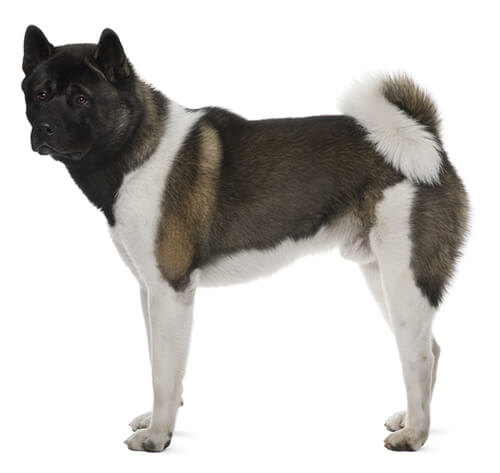
Japanese Akita dogs are large, powerful dogs with much substance and dignity. Their proud head carriage and stance is enhanced by their small ears and dark eyes. They make a striking picture with their thick, plush coats.
The need-to-know
- Dog suitable for experienced owners
- Extra training required
- Enjoys active walks
- Enjoys walking one to two hours a day
- Large dog
- Heavy drool
- Requires grooming daily
- Non hypoallergenic breed
- Quiet dog
- Guard dog. Barks, alerts and it's physically protective
- May require training to live with other pets
- May require training to live with kids
Personality

Not unexpectedly, Akita are strong dogs – in body and character – and are not recommended for the novice owner. They need experienced handling and early and ongoing socialisation and training. They are, however, very loyal to their own family, while aloof and reserved - and generally suspicious - of strangers. Courageous, they make good but often silent watchdogs - a trait that was much admired in their homeland. Their hunting and protective instincts are strong and this must be remembered at all times.
History and Origins

Country of Origin: Japan
The Akita, the largest of all the Japanese breeds, was originally bred in the province of Akita in the 1600 and was originally developed as a highly successful fighting dog. In the late 19th century however, other breeds were imported into the fighting scene making the Japanese breeds suffer in popularity. As dog fighting fell out of favour, the Akita needed to find other jobs to do in order to survive, and managed this effortlessly by multi-tasking as a hunting dog, a guard dog, a police dog, a show dog and a much-loved companion.
Nutrition and Feeding

Large breed dogs, as well as having large appetites, benefit from a balanced diet with many different nutrients including minerals and vitamins compared to smaller-breed dogs. The Japanese Akita is prone to bloating and stomach problems; smaller, more frequent meals can help minimise this risk.
Exercise

Akitas will enjoy as much dog exercise as you want to give them but need one to two hours every day.
Other Information

Health and Common Issues
As with many breeds, the Japanese Akita can suffer from hereditary eye disorders and hip dysplasia (a condition that can lead to mobility problems). Eye testing and hip scoring of dogs prior to breeding is therefore important.
Space Requirements
This is a large dog who needs space and who enjoys having a large secure garden to wander around in and patrol. With their aloofness towards strangers, the Akita does best without close neighbours and constant disruptions and so a more rural home is perfect.
Training Japanese Akita Dogs
As with most big, powerful working dogs, Akitas need a lot of dog training and ongoing socialisation to ensure they are under control and safe around other dogs and people. They have a strong hunting instinct so while a good recall is extremely important to train, it shouldn’t always be relied upon and management is equally as important. While some Akitas enjoy training, many are far less interested in traditional obedience although they are strongly bonded to their owners and rarely wander far from them.
Best Family Dog Breeds
The Japanese Akita doesn’t make a great family dog - as while devoted to their own family, they do not enjoy visitors and the disruptions that come with family life. They can however make good companions in a quiet house with older sensible children. All dogs and children need to be taught to get on with each other and be safe together. Even so, dogs and children should never be left alone together and adults should supervise all interactions between them.
Did You Know?
The most famous Japanese Akita was Hachi, the loyal companion of a Tokyo professor Eizaburo Ueno. Each day Hachi would accompany his master to the train station and would also be waiting for him when he got back from work. On 25th May 1925, Professor Ueno died in his office but for the next nine years and until his own death, Hachi made the lonely journey back and forward to the station waiting for his master who never came. There is a statue at the station in his memory.